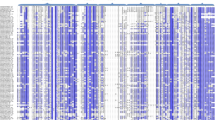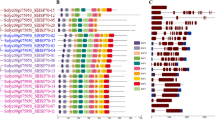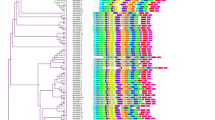Abstract
The small heat shock proteins (sHSPs) are a diverse family of molecular chaperones. It is well established that these proteins are crucial components of the plant heat shock response. They also have important roles in other stress responses and in normal development. We have conducted a comparative sequence analysis of the sHSPs in three complete angiosperms genomes: Arabidopsis thaliana, Populus trichocarpa, and Oryza sativa. Our phylogenetic analysis has identified four additional plant sHSP subfamilies and thus has increased the number of plant sHSP subfamilies from 7 to 11. We have also identified a number of novel sHSP genes in each genome that lack close homologs in other genomes. Using publicly available gene expression data and predicted secondary structures, we have determined that the sHSPs in plants are far more diverse in sequence, expression profile, and in structure than had been previously known. Some of the newly identified subfamilies are not stress regulated, may not posses the highly conserved large oligomer structure, and may not even function as molecular chaperones. We found no consistent evolutionary patterns across the three species studied. For example, gene conversion was found among the sHSPs in O. sativa but not in A. thaliana or P. trichocarpa. Among the three species, P. trichocarpa had the most sHSPs. This was due to an expansion of the cytosolic I sHSPs that was not seen in the other two species. Our analysis indicates that the sHSPs are a dynamic protein family in angiosperms with unexpected levels of diversity.


Similar content being viewed by others
References
Basha E, Friedrich KL, Vierling E (2006) The N-terminal arm of small heat shock proteins is important for both chaperone activity and substrate specificity. J Biol Chem 281:39943–39952
Blanc G, Hokamp K, Wolfe KH (2003) A recent polyploidy superimposed on older large-scale duplications in the Arabidopsis genome. Genome Res 13:137–144
Blanc G, Wolfe KH (2004) Functional divergence of duplicated genes formed by polyploidy during Arabidopsis evolution. Plant Cell 16:1679–1691
Boorstein WR, Ziegelhoffer T, Craig EA (1994) Molecular evolution of the HSP70 multigene family. J Mol Evol 38:1–17
Casneuf T, De Bodt S, Raes J, Maere S, Van de Peer Y (2006) Nonrandom divergence of gene expression following gene and genome duplications in the flowering plant Arabidopsis thaliana. Genome Biol 7:R13
Caspers GJ, Leunissen JA, de Jong WW (1995) The expanding small heat-shock protein family, and structure predictions of the conserved “alpha-crystallin domain”. J Mol Evol 40:238–248
de Jong WW, Caspers GJ, Leunissen JA (1998) Genealogy of the alpha-crystallin-small heat-shock protein superfamily. Int J Biol Macromol 22:151–162
Drouin G (2002) Characterization of the gene conversion between the multigene family members of the yeast genome. J Mol Evol 55:14–23
Duarte JM, Cui L, Wall PK et al (2006) Expression pattern shifts following duplication indicative of subfunctionalization and neofunctionalization in regulatory genes of Arabidopsis. Mol Biol Evol 23:469–478
Force A, Cresko WA, Pickett FB, Proulx SR, Amemiya C, Lynch M (2005) The origin of subfunctions and modular gene regulation. Genetics 170:433–446
Franck E, Madsen O, van Rheede T, Ricard G, Huynen MA, de Jong WW (2004) Evolutionary diversity of vertebrate small heat shock proteins. J Mol Evol 59:792–805
Fu X, Jiao W, Chang Z (2006) Phylogenetic and biochemical studies reveal a potential evolutionary origin of small heat shock proteins of animals from bacterial class A. J Mol Evol 62:257–266
Giese KC, Basha E, Catague BY, Vierling E (2005) Evidence for an essential function of the N terminus of a small heat shock protein in vivo, independent of in vitro chaperone activity. Proc Natl Acad Sci USA 102:18896–18901
Gil R, Sabater-Munoz B, Latorre A, Silva FJ, Moya A (2002) Extreme genome reduction in Buchnera spp.: toward the minimal genome needed for symbiotic life. Proc Natl Acad Sci USA 99:4454–4458
Gil R, Silva FJ, Zientz E et al (2003) The genome sequence of Blochmannia floridanus: comparative analysis of reduced genomes. Proc Natl Acad Sci USA 100:9388–9393
Goff SA, Ricke D, Lan TH et al (2002) A draft sequence of the rice genome (Oryza sativa L. ssp. japonica). Science 296:92–100
Guan J, Jinn T, Yeh C, Feng S, Chen Y, Lin C (2004) Characterization of the genomic structures and selective expression profiles of nine class I small heat shock genes clustered on two chromosomes in rice (Oryza sativa L.). Plant Mol Biol 56:795–809
Gupta RS (1995) Phylogenetic analysis of the 90 kD heat shock family of protein sequences and an examination of the relationships among animals, plants and fungi species. Mol Biol Evol 12:1063–1073
Harberer G, Hindemitt T, Meyers BC, Mayer K (2004) Transcriptional similarities: dissimilarities and conservation of cis-elements in duplicated genes of Arabidopsis. Plant Physiol 136:3009–3022
Haslbeck M, Franzmann T, Weinfurtner D, Buchner J (2005) Some like it hot: the structure and function of small heat-shock proteins. Nat Struct Mol Biol 12:842–846
Haslbeck M, Ignatiou A, Saibil H, Helmich S, Frenzl E, Stromer T, Buchner J (2004) A domain in the N-terminal part of Hsp26 is essential for chaperone function and oligomerization. J Mol Biol 343:445–455
Hughes A (2005) Gene duplication and the origin of novel proteins. Proc Natl Acad Sci USA 102:8791–8792
Kim R, Kim KK, Yokota H, Kim S-H (1998) Small heat shock protein of Methanococcus jannaschii, a hyperthermophile. Proc Natl Acad Sci USA 95:9129–9133
Kotak S, Vierling E, Baumlein H, von Koskull-Doring P (2007) A novel transcriptional cascade regulating expression of heat stress proteins during seed development of Arabidopsis. Plant Cell 19:182–195
Kumar S, Tamura K, Nei M (2004) MEGA3: Integrated software for Molecular Evolutionary Genetics Analysis and sequence alignment. Brief Bioinform 5:150–163
Lee GJ, Vierling E (2000) A small heat shock protein cooperates with heat shock protein 70 systems to reactivate a heat-denatured protein. Plant Physiol 122:189–198
Lee GJ, Pokala N, Vierling E (1995) Structure and in vitro molecular chaperone activity of cytosolic small heat shock proteins from pea. J Biol Chem 270:10432–10438
Lee GJ, Roseman AM, Saibil HR, Vierling E (1997) A small heat shock protein stably binds heat-denatured model substrates and can maintain a substrate in a folding-competent state. EMBO J 16:659–671
Lenne C, Douce R (1994) A low molecular mass heat-shock protein is localized to higher plant mitochondria. Plant Physiol 105:1255–1261
Lynch M, Force A (2000) The probability of duplicate gene preservation by subfunctionalization. Genetics 154:459–473
Ma C, Haslbeck M, Babujee L, Jahn O, Reumann S (2006) Identification and characterization of a stress-inducible and a constitutive small heat-shock protein targeted to the matrix of plant peroxisomes. Plant Physiol 141:47–60
Mondragon-Palomino M, Gaut BS (2005) Gene conversion and the evolution of three leucine-rich repeat gene families in Arabidopsis thaliana. Mol Biol Evol 22:2444–2456
Nakamoto H, Vigh L (2007) The small heat shock proteins and their clients. Cell Mol Life Sci 64:294–306
Narberhaus F (2002) Alpha-crystallin-type heat shock proteins: socializing minichaperones in the context of a multichaperone network. Microbiol Mol Biol Rev 66:64–93
Posada D, Buckley T (2004) Model selection and model averaging in phylogenetics: advantages of Akaike information criterion and Bayesian approaches over likelihood ratio tests. Syst Biol 53:793–808
Remington DL, Vision TJ, Guilfoyle TJ, Reed JW (2004) Contrasting modes of diversification in the Aux/IAA and ARF gene families. Plant Physiol 135:1738–1752
Ronquist F, Huelsenbeck JP (2003) MrBayes 3: Bayesian phylogenetic inference under mixed models. Bioinformatics 19:1572–1574
Ronquist F, Larget B, Huelsenbeck JP, Kadane JB, Simon D, van der Mark P (2006) Comment on “Phylogenetic MCMC algorithms are misleading on mixtures of trees”. Science 312:367 (author reply 367)
Sampedro J, Carey RE, Cosgrove DJ (2006) Genome histories clarify evolution of the expansin superfamily: new insights from the poplar genome and pine ESTs. J Plant Res 119:11–21
Sawyer SA (1999) GENECONV: a computer package for the statistical detection of gene conversion. Distributed by the author. Department of Mathematics, Washington University, St. Louis
Scharf KD, Siddique M, Vierling E (2001) The expanding family of Arabidopsis thaliana small heat stress proteins and a new family of proteins containing alpha-crystallin domains (Acd proteins). Cell Stress Chaperones 6:225–237
Shiu SH, Karlowski WM, Pan R, Tzeng YH, Mayer KF, Li WH (2004) Comparative analysis of the receptor-like kinase family in Arabidopsis and rice. Plant Cell 16:1220–1234
Siddique M, Port M, Tripp J, Weber C, Zielinski D, Calligaris R, Winkelhaus S, Scharf KD (2003) Tomato heat stress protein Hsp16.1-CIII represents a member of a new class of nucleocytoplasmic small heat stress proteins in plants. Cell Stress Chaperones 8:381–394
Stechmann A, Cavalier-Smith T (2003) Phylogenetic analysis of eukaryotes using heat-shock protein Hsp90. J Mol Evol 57:408–419
Sun Y, MacRae TH (2005) Small heat shock proteins: molecular structure and chaperone function. Cell Mol Life Sci 62:2460–2476
Taylor JS, Raes J (2004) Duplication and divergence: the evolution of new genes and old ideas. Annu Rev Genet 38:615–643
Tuskan GA, Difazio S, Jansson S et al (2006) The genome of black cottonwood, Populus trichocarpa (Torr. & Gray). Science 313:1596–1604
van Montfort RL, Basha E, Friedrich KL, Slingsby C, Vierling E (2001) Crystal structure and assembly of a eukaryotic small heat shock protein. Nat Struct Biol 8:1025–1030
van Montfort RL, Slingsby C, Vierling E (2002) Structure and function of the small heat shock protein/alpha-crystallin family of molecular chaperones. Adv Protein Chem 59:105–156
Vierling E (1991) The heat shock response in plants. Annu Rev Plant Physiol Plant Mol Biol 42:579–620
Vierling E, Nagao RT, DeRocher AE, Harris LM (1988) A heat shock protein localized to chloroplasts is a member of a eukaryotic superfamily of heat shock proteins. EMBO J 7:575–581
Vision TJ, Brown DG, Tanksley SD (2000) The origins of genomic duplications in Arabidopsis. Science 290:2114–2117
Wang W, Vinocur B, Shoseyov O, Altman A (2004) Roles of plant heat-shock proteins and molecular chaperones in the abiotic stress response. Trends Plant Sci 9:244–252
Wang X, Shi X, Li Z, Zhu Q, Kong L, Tang W, Ge S, Luo J (2006) Statistical inference of chromosomal homology based on gene colinearity and applications to Arabidopsis and rice. BMC Bioinformatics 7:447
Waters ER (1995) The molecular evolution of the small heat shock proteins in plants. Genetics 141:785–795
Waters ER (2003) Molecular adaptation and the origin of land plants. Mol Phyl Evol 29:456–463
Waters ER, Rioflorido I (2007) Evolutionary analysis of the small heat shock proteins in five complete algal genomes. J Mol Evol 65:162–174
Waters ER, Vierling E (1999a) Chloroplast small heat shock proteins: Evidence for atypical evolution of an organelle-localized protein. Proc Natl Acad Sci USA 96:14394–14399
Waters ER, Vierling E (1999b) The diversification of plant cytosolic small heat shock proteins preceded the divergence of mosses. Mol Biol Evol 16:127–139
Waters ER, Lee G, Vierling E (1996) Evolution, structure and function of the small heat shock proteins in plants. J Exp Bot 47:325–338
Waters ER, Hohn MH, Ahel I et al (2003) The genome of Nanoarchaeum equitans: insights into early archaeal evolution, parasitism and the minimal genome. Proc Natl Acad Sci USA 100:12984–12988
Yang X, Tuskan GA, Cheng MZ (2006) Divergence of the Dof gene families in poplar, Arabidopsis, and rice suggests multiple modes of gene evolution after duplication. Plant Physiol 142:820–830
Yazaki J, Kojima K, Suzuki K, Kishimoto N, Kikuchi S (2004) The Rice PIPELINE: a unification tool for plant functional genomics. Nucleic Acids Res 32:D383–D387
Yu J, Hu S, Wang J et al (2002) A draft sequence of the rice genome (Oryza sativa L. ssp. indica). Science 296:79–92
Zhang L, Vision TJ, Gaut BS (2002) Patterns of nucleotide substitution among simultaneously duplicated gene pairs in Arabidopsis thaliana. Mol Biol Evol 19:1464–1473
Zimmermann P, Hirsch-Hoffmann M, Hennig L, Gruissem W (2004) GENEVESTIGATOR Arabidopsis Microarray Database and Analysis Toolbox. Plant Physiol 136:2621–2632
Acknowledgements
We thank two anonymous reviewers for their careful reading of and helpful comments on an earlier version of this manuscript. This work was partially supported by award IBN:0313900 to ERW from the National Science Foundation. Z. Sanders-Reed was partially supported by the HCOP program at SDSU.
Author information
Authors and Affiliations
Corresponding author
Electronic supplementary material
Below is the link to the electronic supplementary material.
Supplementary Fig. 1
Alignment of sHSP amino acid sequences (DOC 67.5 KB)
Supplementary Fig. 2–4
A. thaliana cytosolic I DNA alignment (DOC 67.0 KB)
Supplementary Table 1
Synonymous (Ks) and Nonsynonymous substitutions for the Cytosolic I genes (DOC 118 KB)
Rights and permissions
About this article
Cite this article
Waters, E.R., Aevermann, B.D. & Sanders-Reed, Z. Comparative analysis of the small heat shock proteins in three angiosperm genomes identifies new subfamilies and reveals diverse evolutionary patterns. Cell Stress and Chaperones 13, 127–142 (2008). https://doi.org/10.1007/s12192-008-0023-7
Received:
Revised:
Accepted:
Published:
Issue Date:
DOI: https://doi.org/10.1007/s12192-008-0023-7




